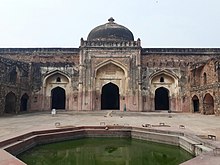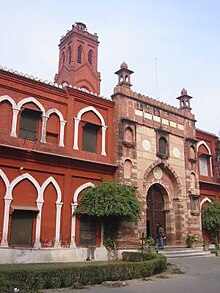History of education in the Indian subcontinent
[1] The earliest educational institutions in India were often isolated from populated areas,[1] where students followed strict monastic rules set by their guru and lived in ashrams away from cities.
In addition to monastic training, Buddhist centers of learning such as Taxila and Nalanda evolved as urban institutions where subjects like grammar, medicine, philosophy, logic, metaphysics, arts, and crafts were taught.
[1][2] These early Buddhist institutions of higher learning, including Taxila and Nalanda, continued to thrive well into the Common Era and attracted students from regions as far as China and Central Asia.
[14] By the 10th–11th centuries, the number of monks at Uddandapura reached a thousand, matching the strength of the monastic community at the sacred Mahabodhi complex.
[18] Another notable center emerged in Lucknow under Mulla Nizamuddin Sahlawi, who taught at Firangi Mahal and developed the Dars-i-Nizami curriculum.
[18] Under Akbar's rule, the education system adopted an inclusive approach, with the monarch encouraging courses in medicine, agriculture, geography, and texts from various languages and religions, including Patanjali's work in Sanskrit.
[20] A tutor, or riyazi, was an educated professional who could earn a suitable living by performing tasks such as creating calendars or generating revenue estimates for the nobility.
[20] Another trend during this era was the mobility among professions, exemplified by Qaim Khan, a prince renowned for his mastery in crafting leather shoes and forging cannons.
[25][26] Dharampal's pioneering historical research, conducted over a decade, provides evidence from early British administrators' reports of the widespread presence of indigenous educational institutions in the Bombay, Bengal, and Madras Presidencies, as well as in the Punjab.
[27] Austrian missionary, linguist, and orientalist Paulinus of St. Bartholomew spent 13 years traveling the Malabar Coast of Hyder Ali's Kingdom of Mysore, starting in 1776.
The writing master, called Agian, or Eluttacien, who stations himself opposite to his pupils, examines what they have done; points out their faults, and shows them how to correct them.
At first, he attends them standing; but when the young people have acquired some readiness in writing, he places himself cross-legged on a tiger or deer skin, or even on a mat made of the leaves of the coconut-tree, or wild bananas, which is called Kaida*, plaited together.
This method of teaching writing was introduced into India two hundred years before the birth of Christ, according to the testimony of Magasthenes, and still continues to be practised.
His pupils must throw themselves down at full length before him; place their right hand on their mouth, and not venture to speak a single word until he gives them express permission.
Those who talk and prate contrary to the prohibition of their master are expelled from the school, as boys who cannot restrain their tongue, and who are consequently unfit for the study of philosophy.
This report detailed village schools where boys, typically between the ages of 5–6 and 10–12, received instruction from a respectable guru at or near his home for a small fee.
Prendergast, a member of the Governor's Council in the Bombay Presidency, recorded the following about indigenous schools on 27 June 1821:[34] "I need hardly mention what every member of the Board knows as well as I do, that there is hardly a village, great or small, throughout our territories, in which there is not at least one school, and in larger villages more; many in every town, and in large cities in every division; where young natives are taught reading, writing and arithmetic, upon a system so economical, from a handful or two of grain, to perhaps a rupee per month to the school master, according to the ability of the parents, and at the same time so simple and effectual, that there is hardly a cultivator or petty dealer who is not competent to keep his own accounts with a degree of accuracy, in my opinion, beyond what we meet with amongst the lower orders in our own country.
The French traveler François Pyrard de Laval, who visited Goa around 1608, described the College of St. Paul and praised the variety of subjects taught there free of charge.
On the other hand, utilitarians (also known as anglicists), such as Lord William Bentinck and Thomas Macaulay, argued that traditional India had little to offer in terms of modern skills, and they advocated for education in English.
"[47][48][49] In 1854, the Wood's despatch to the then Governor-General Dalhousie stipulated a number of reforms to be made to the Company's education system in British India.
The effectiveness of the measures outlined in the Wood's despatch was subsequently reviewed, and a number of changes were made following the publication of William Hunter's Report of the Indian Education Commission in 1882, which was released in 1883.
To advance their careers, many ambitious upper-class men, including Gandhi, Nehru, and Muhammad Ali Jinnah, traveled to England, particularly to obtain legal education at the Inns of Court.
The intellectual support provided by the university played a significant role in the success of Muhammad Ali Jinnah and the Muslim League.
[55] At the 21st Conference of the Indian National Congress in Benares in December 1905, Madan Mohan Malaviya publicly announced his intent to establish a university in Varanasi.
[64] Sociologist Hetukar Jha argued that local schools for pre-adolescent children were flourishing in thousands of villages in Bihar and Bengal until the early decades of the nineteenth century.
Gradually, by the end of the nineteenth century, the village as a base of secular identity and solidarity became too weak to create and maintain its own institutions, leading to the decay of the traditional system.
[65] Deepak Kumar argues that British colonial rule during the 19th century did not take adequate measures to help develop Western science and technology in India, instead focusing more on the arts and humanities.
[69] While some science-related subjects were not included in the government curriculum in the 1850s,[citation needed] private institutions also could not offer science courses due to a lack of funds required to establish laboratories and other necessary facilities.
[71] However, Kumar notes the British turn towards professional education during the 1860s, as well as French initiatives aimed at raising awareness of science and technology in their colonies.
[72] This program tripled the kingdom's literacy rate from 9% to 27% between 1906 and 1939 and resulted in primary school provision for approximately 80% of the target population by the end of the period.









